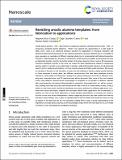Por favor, use este identificador para citar o enlazar a este item:
http://hdl.handle.net/10261/260653COMPARTIR / EXPORTAR:
 SHARE
BASE SHARE
BASE
|
|
| Visualizar otros formatos: MARC | Dublin Core | RDF | ORE | MODS | METS | DIDL | DATACITE | |

| Título: | Revisiting anodic alumina templates: From fabrication to applications |
Autor: | Ruiz-Clavijo, Alejandra CSIC ORCID; Caballero-Calero, Olga CSIC ORCID; Martín-González, Marisol CSIC ORCID | Fecha de publicación: | 7-ene-2021 | Editor: | Royal Society of Chemistry (UK) | Citación: | Nanoscale 13(4): 2227-2265 (2021) | Resumen: | Anodic porous alumina, -AAO- (also known as nanoporous alumina, nanohole alumina arrays, -NAA- or nanoporous anodized alumina platforms, -NAAP-) has opened new opportunities in a wide range of fields, and is used as an advanced photonic structure for applications in structural coloration and advanced optical biosensing based on the ordered nanoporous structure obtained and as a template to grow nanowires or nanotubes of different materials giving rise to metamaterials with tailored properties. Therefore, understanding the structure of nanoporous anodic alumina templates and knowing how they are fabricated provide a tool for the further design of structures based on them, such as 3D nanoporous structures developed recently. In this work, we review the latest developments related to nanoporous alumina, which is currently a very active field, to provide a solid and thorough reference for all interested experts, both in academia and industry, on these nanostructured and highly useful structures. We present an overview of theories on the formation of pores and self-ordering in alumina, paying special attention to those presented in recent years, and different nanostructures that have been developed recently. Therefore, a wide variety of architectures, ranging from ordered nanoporous structures to diameter changing pores, branched pores, and 3D nanostructures will be discussed. Next, some of the most relevant results using different nanostructured morphologies as templates for the growth of different materials with novel properties and reduced dimensionality in magnetism, thermoelectricity, etc. will be summarised, showing how these structures have influenced the state of the art in a wide variety of fields. Finally, a review on how these anodic aluminium membranes are used as platforms for different applications combined with optical techniques, together with principles behind these applications will be presented, in addition to a hint on the future applications of these versatile nanomaterials. In summary, this review is focused on the most recent developments, without neglecting the basis and older studies that have led the way to these findings. Thus, it gives an updated state-of-the-art review that should be useful not only for experts in the field, but also for non-specialists, helping them to gain a broad understanding of the importance of anodic porous alumina, and most probably, endow them with new ideas for its use in fields of interest or even developing the anodization technique. | Versión del editor: | http://dx.doi.org/10.1039/d0nr07582e | URI: | http://hdl.handle.net/10261/260653 | DOI: | 10.1039/d0nr07582e | Identificadores: | doi: 10.1039/d0nr07582e e-issn: 2040-3372 issn: 2040-3364 |
| Aparece en las colecciones: | (IMN-CNM) Artículos |
Ficheros en este ítem:
| Fichero | Descripción | Tamaño | Formato | |
|---|---|---|---|---|
| d0nr07582e.pdf | 6,95 MB | Adobe PDF |  Visualizar/Abrir |
CORE Recommender
Page view(s)
25
checked on 22-may-2024
Download(s)
96
checked on 22-may-2024
Google ScholarTM
Check
Altmetric
Altmetric
Este item está licenciado bajo una Licencia Creative Commons

